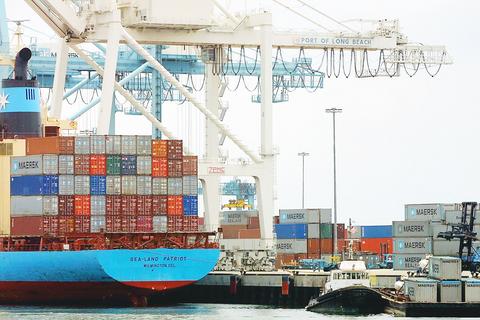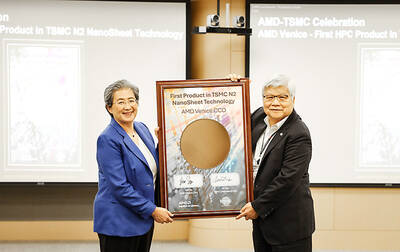For decades, the West Coast longshoremen's union could boast that its members had some of the highest-paying blue-collar jobs in the nation. Workers who unload ships commonly earn more than US$85,000 a year.
But now the longshoremen fear that their jobs -- and those of future generations of longshoremen -- are under siege.

PHOTO: NY TIMES
Those fears could lead to a shutdown of all seaports from San Diego to Seattle on July 1 -- a move that could send shock waves through the nation's already fragile economy.
In the giant Los Angeles-Long Beach port complex, by far the nation's largest port, burly longshoremen complain that the shipping companies want to install more computerized technology that they fear could throw hundreds of union members out of work -- and take away jobs for future dockworkers.
But officials with the shipping companies insist that their role is to run an efficient port, not to protect the jobs of the unborn.
The shipping companies complain about work rules dating from the 1940s and argue that more modern rules -- and more modern technologies -- are needed or the West Coast ports will choke on their own inefficiencies.
These clashing views could lead to the biggest work stoppage on the waterfront since 1971, when the longshoremen staged a four-month strike. While officials with the International Longshore and Warehouse Union say they have no plans to call a strike, the shipping companies fear that the workers will stage a job slowdown if no contract is reached by July 1.
Union members say they worry that management will beat them to the punch and lock out the 10,500 West Coast longshoremen, who remove cargo from ships and record all merchandise that goes in or out of the ports.
"If you have a shutdown of these ports, it would be devastating," said Jack Kyser, chief economist of the Los Angeles County Economic Development Corp "It's not just what it would do to the West Coast economy, it's what it would do to the US economy."
A study by Stephen Cohen, a professor at the University of California , estimated that a five-day work stoppage would cost the nation's economy US$4.7 billion and the cost of a 20-day stoppage would be US$48.6 billion. The West Coast ports handle more than US$300 billion in goods annually, directly affecting 7 percent of the nation's economic output.
Department stores, car dealers, hardware companies and many other businesses fear that a shutdown of the ports could quickly interrupt their supply lines.
Begging for a settlement
That explains why business groups across the nation are pressuring the union and the management group, the Pacific Maritime Association, which represents shipping lines and stevedores, to reach a settlement before July 1.
But not much optimism is heard about the negotiations, and that, economists say, is one reason Wall Street has slumped in recent weeks. As a result of the pessimism, some business groups are urging President Bush to use his powers under the Taft-Hartley Act to order a cooling off period to delay and possibly prevent a strike, slowdown or lockout.
"It's hard to think that all this is being managed in a way that it will be resolved by July 1," said Robin Lanier, executive director of the West Coast Waterfront Coalition, which represents a range of companies, from shipping lines to retailers like Target and automakers like Toyota.
For months before negotiations officially began on May 13, management officials said the crucial issue was technology. They said greater use of technology would save money, reduce the two-hour lines of trucks waiting to enter the ports and increase security in cargo-handling when the nation fears new terrorist attacks.
Management hates rules like the one that requires clerks in the longshoremen's union to type in information about all arriving merchandise when that information was already typed in when ships left Asia.
A study by Michael Nacht, a public policy professor at the University of California, found that not using technology more efficiently costs the shipping industry at least US$1 billion a year.
"We cannot avoid the issue of new technology," Joseph Miniace, president of the Pacific Maritime Association, told the union when negotiations began last month. "Currently, the West Coast is behind. We must see to it that the West Coast moves to the forefront."
While acknowledging that technology might reduce the number of jobs, management negotiators promised that it would not cause layoffs for any current workers. Many longshoremen are unimpressed by that promise because they do not trust management. But that is not the only reason union members fear more technology.
A legacy
"The union doesn't look at these jobs as jobs to trade away," Steve Stallone, the union's spokesman, said when the negotiations began. "We hold these jobs in trust to pass down to other people in the community. We negotiate for the next generation of longshoremen."
Union officials insist that theirs is an enlightened union that has often entertained the greater use of technology. They point to the landmark agreements of the 1960s that allowed ports to handle cargo in large containers. In return, the union shared in the rising profits -- in the form of unusually high wages -- made possible by modernization.
Some union officials acknowledge that the focus on technology has put them on the defensive. They point to other important issues in the talks, among them management's proposals to require retirees and current workers to begin contributing toward their health insurance.
"It's not fair that all these foreign-owned shipping lines want American workers and elderly American retirees who live on a fixed income to pay more for health coverage," said Ramon Ponce de Leon Jr., president of the largest longshoremen's local for the Los Angeles-Long Beach port.
In a brief interview, Miniace and James Spinosa, the union's president, defended the pace of the talks. They said in a joint statement that the two sides had successfully negotiated contracts over the past 30 years, and that "we are confident that we will succeed again."

UNCERTAINTY: Innolux activated a stringent supply chain management mechanism, as it did during the COVID-19 pandemic, to ensure optimal inventory levels for customers Flat-panel display makers AUO Corp (友達) and Innolux Corp (群創) yesterday said that about 12 to 20 percent of their display business is at risk of potential US tariffs and that they would relocate production or shipment destinations to mitigate the levies’ effects. US tariffs would have a direct impact of US$200 million on AUO’s revenue, company chairman Paul Peng (彭雙浪) told reporters on the sidelines of the Touch Taiwan trade show in Taipei yesterday. That would make up about 12 percent of the company’s overall revenue. To cope with the tariff uncertainty, AUO plans to allocate its production to manufacturing facilities in

TAKING STOCK: A Taiwanese cookware firm in Vietnam urged customers to assess inventory or place orders early so shipments can reach the US while tariffs are paused Taiwanese businesses in Vietnam are exploring alternatives after the White House imposed a 46 percent import duty on Vietnamese goods, following US President Donald Trump’s announcement of “reciprocal” tariffs on the US’ trading partners. Lo Shih-liang (羅世良), chairman of Brico Industry Co (裕茂工業), a Taiwanese company that manufactures cast iron cookware and stove components in Vietnam, said that more than 40 percent of his business was tied to the US market, describing the constant US policy shifts as an emotional roller coaster. “I work during the day and stay up all night watching the news. I’ve been following US news until 3am

COLLABORATION: Given Taiwan’s key position in global supply chains, the US firm is discussing strategies with local partners and clients to deal with global uncertainties Advanced Micro Devices Inc (AMD) yesterday said it is meeting with local ecosystem partners, including Taiwan Semiconductor Manufacturing Co (TSMC, 台積電), to discuss strategies, including long-term manufacturing, to navigate uncertainties such as US tariffs, as Taiwan occupies an important position in global supply chains. AMD chief executive officer Lisa Su (蘇姿丰) told reporters that Taiwan is an important part of the chip designer’s ecosystem and she is discussing with partners and customers in Taiwan to forge strong collaborations on different areas during this critical period. AMD has just become the first artificial-intelligence (AI) server chip customer of TSMC to utilize its advanced

Six years ago, LVMH’s billionaire CEO Bernard Arnault and US President Donald Trump cut the blue ribbon on a factory in rural Texas that would make designer handbags for Louis Vuitton, one of the world’s best-known luxury brands. However, since the high-profile opening, the factory has faced a host of problems limiting production, 11 former Louis Vuitton employees said. The site has consistently ranked among the worst-performing for Louis Vuitton globally, “significantly” underperforming other facilities, said three former Louis Vuitton workers and a senior industry source, who cited internal rankings shared with staff. The plant’s problems — which have not